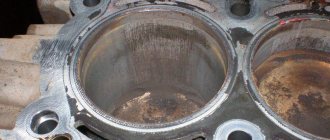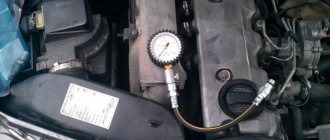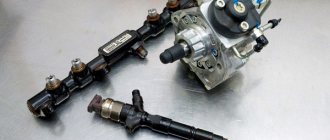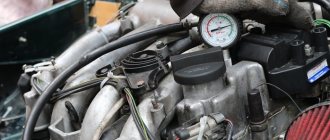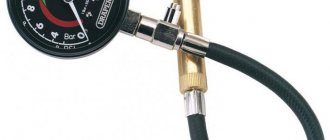Checking engine compression
An engine compression test is performed to find faults in an internal combustion engine. Compression is the compression of the mixture in the cylinder under the influence of external forces. It is measured as the compression ratio multiplied by 1.3. When measuring compression, you can find a cylinder that is malfunctioning .
If the car has various kinds of problems, such as a drop in power, loss of oil, friction in the engine, then check the spark plugs, sensors, and inspect the engine for damage and leaks. When such checks do not bring results, then they resort to measuring compression. How to determine it using the example of a VAZ classic is shown in this video.
yourself using a compression gauge . At service stations, such checks are done using a compressor or motor tester.
How to measure engine compression
First you need to prepare the engine for testing. To do this, we need to warm up the engine to a high temperature of 70-90 degrees. After this, you need to turn off the fuel pump so that no fuel is supplied and remove the spark plugs.
After all this, we move on to checking the compression :
Illustration of the stages of measuring compression in a cylinder
There is another method of checking, which differs from the above in that engine oil is poured into the cylinder being tested. An increase in pressure indicates worn out piston rings; if the pressure does not increase, then the reason is the cylinder head gasket , or there is a leak in the valves.
Weak compression can also be diagnosed by malfunctions in the carburetor. If there is an air leak, check the fit of the bypass valve. If air leaks out of the top of the radiator, then a faulty cylinder head is to blame.
Measuring compression in your car’s engine: how to do it?
Measuring engine compression with a mechanical compression meter is carried out according to the following algorithm. You should remove all the spark plugs from the cylinders and crank the engine crankshaft idle, measuring the compression in each cylinder in turn:
— it is desirable that the engine is warm, although this is not critical;
— the fuel supply must be clearly turned off;
Compression measurement on 2-stroke engines
— if the engine is cranked by the starter, then the battery must be charged and the starter, accordingly, must be in working order;
— the engine can also be cranked manually using the crank (if there is one) or using the appropriate key on the ratchet; cranking the gears, belt or chain of the timing mechanism by hand will not give correct compression measurement results.
At a professional car service center, compression is measured with the throttle valve open and closed, and the difference in readings may indirectly indicate some defects in engine operation. When the damper is closed, less air will flow into the cylinders, and the compression will be low - about 0.6-0.8 MPa. When the throttle is open, the picture will be different - the causes of engine defects can be determined from the attached table at the bottom of the article.
In any case, one should take into account not only the dynamics of pressure increase, but also the maximum compression values. And most importantly, in any case, the results of compression measurements in cylinders are calculated, relative values, and one should rely specifically on the difference in pressure in different cylinders. If in three cylinders the compression is, for example, 11-12 atm, and in the fourth cylinder it is 7-8 atm, then the problem is concentrated there. Here we should look for the reasons for the loss of tightness of the cylinder-piston group.
READ How to Correctly Put a Chain on a Chainsaw
Measuring compression in a diesel engine
Compression test on a diesel engine.
Compression measurement on an injection car
It is worth remembering that compression measurements can be inaccurate. For the most part, measurements need to take into account the pressure difference between the cylinders, and not the average compression value.
You should definitely take into account such parameters as oil, engine, air temperature, engine rotation speed, etc. Only taking into account all the parameters can one draw a conclusion about the degree of wear of the pistons and other parts that affect compression. And as a result of all these malfunctions, give a conclusion about the need for a major overhaul of the engine.
How to check compression without a compression gauge
Without a device you won't be able to measure compression. Because the word “measurement” itself implies the use of a measuring device. So it is impossible to measure compression in an engine without a compression gauge . But if you need to check to determine whether it exists at all (for example, after a broken timing belt or a long period of inactivity of the car, etc.), then there are several simple ways to check compression without a compression gauge. A sign of poor compression is the atypical behavior of the car, when, for example, at low speeds it works sluggishly and unsteadily, and at high speeds it “wakes up”, while their exhaust smoke is bluish, and if you look at the spark plugs, they will be in oil. As compression decreases, the pressure of crankcase gases increases, the ventilation system becomes dirty faster and, as a result, CO toxicity increases and combustion chamber contamination increases.
Checking compression without instruments
The most basic way to check engine compression without instruments is by ear . So, as usual, if there is compression in the engine cylinders, then by rotating the starter you can hear how the engine works out each compression stroke with a characteristic sound. Moreover, in most cases the engine may sway a little. When there is no compression, then neither clear beats will be heard, nor will there be any trembling. This behavior often indicates a broken timing belt.
Video on how to check engine compression without instruments
By plugging the spark plug well with a plug of a suitable diameter (rubber, cortical plastic or thick rag) , and first unscrewing the spark plug of one of the cylinders, you can check if there is at least some compression. After all, if it is there, the cork will fly out with a characteristic pop. If there is no compression, it will remain where it was.
The applied force when turning the HF . This method of checking compression has no accuracy at all, but, nevertheless, people sometimes use it. You need to unscrew all the spark plugs, except for the first cylinder, and turn them by hand using the crankshaft pulley bolt until the compression stroke ends (determined by the timing marks). Next, we repeat the same procedure with all other cylinders, approximately remembering the applied force. Since the measurements are rather arbitrary, it is preferable to use a compression meter. Every car owner should have such a device, because its price is so high that it is not worth buying, and its help may be needed at any time. You can find out the required compression value for your car from the service manual, or at least find out the compression ratio of your car's engine, then the compression can be calculated using the formula: compression ratio * K (where K = 1.3 for gasoline and 1.3-1, 7 for diesel internal combustion engines).
Based on the condition of the exhaust or the condition of the spark plugs , only an experienced mechanic can determine the compression without a device, and then the same thing is relative.
This method is relevant for cars with a worn-out engine , when topping up has become more frequent, and blue-white smoke with a specific odor appears from the muffler. This will indicate that oil has begun to flow into the combustion chambers in several ways. A competent mechanic in the exhaust and the condition of the spark plugs, as well as after analyzing the acoustic noise (to listen to the noise you will need a device, which is a medical stethoscope with a mechanical sensor), will accurately determine what is causing the smoke and oil consumption.
There are two main culprits for the presence of oil, these are oil reflective valve caps or the cylinder-piston group (rings, pistons, cylinders), which indicates deviations in compression.
How to measure engine compression
To check this parameter, use a special device - a compression meter, which is freely available at an affordable price. There is a more expensive device - a compression tester, which allows you to measure engine compression with the same result, but with the ability to graphically record the measurements. Let's consider the sequence of actions when measuring on gasoline and diesel engines, as well as how to correctly measure compression without having the above instruments at hand. All the methods described below have been repeatedly tested by motorists and have proven their relevance. However, to be sure, it is recommended to measure the compression in the cylinders by contacting a service station.
Taking measurements on a gasoline engine
The main rule when measuring is to warm up the power unit to temperatures of 70-80 degrees. Usually it works until the cooling system fan starts for the first time, then it turns off. Those who know how to properly check the compression in a gasoline engine understand that this is necessary to increase the fluidity of the engine oil. Next, you need to turn off the fuel supply so that it does not enter the combustion chambers during measurement. An engine compression test cannot be performed with the spark plugs screwed in, so they all come out. Instead of a spark plug, a compression gauge is screwed into the cylinder under test.
When the first cylinder is prepared, you can check the compression in it. To do this, start the starter and rotate the crankshaft until the pressure on the compression gauge stops increasing. The maximum value is recorded and compared with the factory value. Now, knowing how to measure compression, you need to perform the same operation in each cylinder. This will allow you to determine in which of them the piston group parts are worn out. If the pressure drops rapidly in all cylinders after the crankshaft stops, the cylinder head gasket definitely needs to be replaced.
How to check compression on a diesel engine
As in the case of a gasoline power unit, it must be warmed up, the fuel supply must be turned off and all glow plugs must be unscrewed. A compression gauge is screwed into one cylinder, and the crankshaft rotates with the help of a starter. Anyone can measure engine compression in this way, since no special experience is required. The maximum values of the compression meter are recorded and compared with the factory values. Thus, measuring compression on a diesel engine repeats the same operations as on a gasoline engine. The end result differs between engines, as petrol and diesel engines have different cylinder pressures.
How to check compression without a compression gauge
Without such a device at hand, you can take less accurate measurements manually. To do this, you only need a key. It is necessary to unscrew the spark plugs in all cylinders except one, thus leaving it sealed. One front wheel is removed and the crankshaft is turned manually using a wrench. Checking compression without a compression gauge means that some effort must be made to turn the crankshaft. By repeating this operation with each cylinder, you can understand which one has the lower pressure by comparing the efforts applied. Such a compression measurement in the engine can only be performed by a person who has experience in such tasks. Since the result is not accurate enough, such a measurement can be used to understand that you need to contact a car service.
Checking compression on a cold engine
If the engine cannot be started, one of the reasons may be failure of the piston group parts. In this case, you will have to measure compression provided that the power unit is at ambient temperature. Compression measurements when cold are performed in the same way as when they are hot. However, pressure readings will vary and this should be taken into account. When the engine is hot, the pressure in the cylinders is several atmospheres higher, and you need to understand the difference in order to determine the performance of the power unit.
How to check compression on a removed engine
Considering that the removed engine is at ambient temperature, it is necessary to understand that the pressure in the cylinders will be several atmospheres less, as when measuring the installed power unit when it is cold. To measure engine compression in this case, you also need to turn the crankshaft manually with a wrench. As when measuring cold, this must be done with one sealed cylinder, changing them one by one. By analyzing the forces that have to be applied, you can find the cylinder with the least compression.
Compression measurement results
The results of compression measurements show the condition of the engine, in particular the pistons, piston rings, valves, camshafts, and allow decisions to be made about the need for repair or just replacement of the head gasket or valve stem seals.
On gasoline engines, normal compression is in the range of 12-15 bar. If we take a closer look, the trend will be as follows:
The table below shows more accurate compression pressure values for different engines:
| engine's type | Value, bar | Wear limit, bar |
| 1.6, 2.0 l | 10,0 — 13,0 | 7,0 |
| 1.8 l | 9,0 — 14,0 | 7,5 |
| 3.0, 4.2 l | 10,0 — 14,0 | 9,0 |
| 1.9 L TDI | 25,0 — 31,0 | 19,0 |
| 2.5 l TDI | 24,0 — 33,0 | 24,0 |
Results of growth dynamics
When the pressure is 2–3 kgf/cm² , and then, during the cranking process, rises sharply, the compression rings are most likely worn out . In the same case, compression increases sharply during the first stroke of operation if oil is dropped into the cylinder.
When the pressure immediately reaches 6–9 kgf/cm² and then practically does not change, then most likely the valves are not tight (grinding in will correct the situation) or the cylinder head gasket is worn out .
In the case when there is a decrease in compression (by about 20% ) in one of the cylinders , and the engine is idling unstably, then there is a high probability of wear on the camshaft cam .
If the results of compression measurements showed that in one of the cylinders (or two adjacent ones), the pressure rises noticeably more slowly and by 3-5 atm. below normal , then the gasket between the block and the head has probably burned out (you need to pay attention to the oil in the coolant).
By the way, you shouldn’t be happy if your engine is old, and the compression has become higher than on a new one - the increase in compression is explained by the fact that as a result of long operation, the combustion chamber has oil deposits that not only worsen heat dissipation, but also reduce its volume, and as a result, detonation appears glow ignition and similar problems.
Uneven compression across the cylinders causes engine vibration (especially noticeable at idle and low speeds), which in turn also harms the transmission and engine suspension. So, having measured the compression pressure, you definitely need to draw conclusions and eliminate the defect.
Source
Checking engine compression without a compression gauge
As is known, the compression indicator in the engine allows you to obtain certain information about the condition of the engine without disassembling and troubleshooting the power unit. Compression measurement is a diagnostic operation that conditionally allows one to evaluate the “tightness” of the cylinder and the efficiency of compression of the mixture.
Next, we will talk about what methods allow you to measure compression in cylinders, what malfunctions are indicated by a decrease in compression, as well as how to determine compression in an engine without a device, that is, perform the necessary diagnostics in the field if necessary.
Summarize
In the article we discussed several ways to check engine pressure. Of course, each of them has the right to life, but the best option is still to purchase a compression meter and take measurements with this device. After all, it is precisely for these purposes that it was created. The cases described above should be used only when you urgently need to check the compression in the engine without instruments, for example, on the road.
That's all we wanted to say today in our article. Now you know how to check the compression in the cylinders with your own hands. We hope that this material was useful to you. You can leave your opinion in the comments.
New articles
- How to check the pump without removing it from the engine?
- Is it possible to put diesel engine oil into a gasoline engine?
Engine compression: what is it and what does deviation from the norm lead to?
As for the compression itself, without going into details, this is the pressure in the cylinder. The indicated pressure directly depends on the compression ratio in a particular engine. To measure compression, the maximum air pressure at the end of the compression stroke is measured.
If we talk about internal combustion engine problems, a decrease in compression leads to the fact that the fuel-air mixture in the cylinder will not be compressed enough for normal combustion of the charge. As a result, the power unit may start with great difficulty, operate unstably, or trip (one or more cylinders do not work or work intermittently). There is also a decrease in power, increased fuel consumption, etc.
Compression measurement: without a compression meter or using special equipment
So, in practice, only two methods are actively used that allow compression measurements to be taken:
Naturally, the presence of a device allows you to obtain the most accurate readings, however, in emergency cases or to obtain approximate estimated results, the decision to measure compression manually is also practiced.
Let us immediately note that in order to measure compression without instruments, certain skills and knowledge will be required, and the operation does not present any great difficulties, even for novice car enthusiasts.
Note that although the method is quite primitive, in some cases even it allows you to get a general idea and identify a problem in a particular engine cylinder. More accurate measurements can only be made using a compression gauge.
It is also important to understand that it is not recommended to continue operating an engine in which compression is reduced in one or more cylinders for a long time. The fact is that the parts in this cylinder will wear out even more, the engine itself will vibrate more strongly and operate unstably, unburned fuel will flow into the oil pan in excess, which will cause dilution of the oil, thereby increasing the overall wear of the internal combustion engine, etc.
Low compression and how to understand what the problem is: CPG, ring or valve
As already mentioned, decreased compression can occur for various reasons. In this case, quite often this is caused by the occurrence, wear or destruction of piston rings. To check the rings in place without disassembling the engine, you can use an accessible method of checking using engine oil. All you need to have on hand is a spark plug wrench, some oil and a syringe.
If the compression indicator increases slightly after adding oil, then problems with the valves are quite possible (for example, valve burnout, etc.). The piston rings may also be severely damaged, as well as the cylinder head gasket may be punctured.
The complete absence of any changes means that the tightness of the combustion chamber is compromised due to any problems with the valve mechanism. It is quite possible that the valves do not fit tightly to the seats, that is, they need to be adjusted, ground in, etc. Also, cracks and breakdowns in the cylinder head or cylinder head should not be ruled out.
What's the result?
As you can see, the need to measure compression may arise for various reasons. This procedure is often used as part of a general diagnosis of the internal combustion engine. Measurements are also taken after the engine has been assembled after repair (both major and overhaul). This is necessary to identify possible defects after assembly.
Also, if necessary, the device can be made independently, using a pressure gauge, tubes and various adapters. For this reason (especially owners of cars with significant mileage) it is recommended to have a separate ready-made measuring device in the car.
How to determine a burnt engine valve yourself. The main symptoms of a burnt valve, exact clarification of the causes of engine tripping. Diagnostics, useful tips.
How to independently determine that the cylinder head gasket has burned out. Recommendations for pulling the cylinder head after replacement. Which gasket is better to choose?
Engine trouble: symptoms. Why does tripping occur and how to find the reason why the motor starts to trip. Checking power, ignition, compression, etc.
Valves knock on a cold engine or after warming up the engine: possible causes of valve mechanism knocking. Fault diagnosis, useful tips.
High compression in the engine and the main reasons for increased compression. Why does compression also decrease across the cylinders? Tips and tricks.
Problems starting a diesel engine. Signs of low compression and causes of malfunction: timing belt, cylinder mirror, piston and rings. We measure the compression.
Source
How to check compression in a car engine with your own hands?
Checking the compression of engine cylinders is recommended in almost any instructions when troubleshooting: when the engine has oil, when it stalls under any circumstances, when the car is idling poorly, or simply when its power drops. In many cases, the cause of such problems can be poor compression in the engine, and in order to identify the cause, you need to know what the compression should be specifically in the engine of your car model and how to check this very compression. Compression is the pressure of compressed air in a cylinder at the very end of the compression stroke, when this pressure is maximum.
We decided to write this instruction because measuring compression in cylinders is a very simple task. You will need to measure the compression in each cylinder in turn, while the engine is rotating from the starter drive, but not running on fuel on its own. Then all you have to do is compare the pressure readings in all cylinders with each other and with the pressure indicated in the characteristics of your car (operating instructions or any other reliable source of advanced engine characteristics of your car).
How to check engine compression?
To check, you will definitely need an indispensable attribute of our work - a compression tester, and you will have to buy it at the nearest auto store or simply ask a familiar auto mechanic, a thrifty or avid car enthusiast, or rent it. A compression gauge is a very inexpensive thing and costs a little more than a pressure gauge, although prices for the former vary much more. In general, the cheapest compression meter will cost you 400-1000 rubles, but there are also more professional devices that cost up to 10-15 thousand rubles, but you are unlikely to need them.
When choosing a compression gauge, you need to make sure that its tip is screwed into the spark plug channel (there are those that mercilessly get clogged there), so that the tip and the pressure gauge itself are connected to each other with a flexible hose and not a tube, since in the latter case you may have to remove something else from under the hood, since it will simply get in our way when installing the compression gauge. Also, see that the maximum pressure jackal reaches at least 20 kg/cm2. If the car needs the hands of a master, then use the rental car https://rentamur.ru/ while your car is at the service station.
Compression gauge with adapter attachments for different types of spark plugs
In addition to the compression gauge, you will need an assistant who will turn the starter using the ignition key from the passenger compartment, and a spark plug wrench. Also, your car must have a working starter and, most importantly, an excellent battery condition, since it will have to work quite a lot.
For accurate and correct measurements, you will need to take the following steps:
The procedure for connecting a compression gauge to check compression in the engine: remove the high-voltage wires from the spark plugs; unscrew all the spark plugs; screw in a compression gauge instead of spark plugs one by one
The compression rate for each engine is different, but in general it is considered normal for a gasoline engine to be about 10-12 kg/cm2. However, check this information for your vehicle model and specification.
If any cylinder has lost compression
If one or more cylinders give a compression reading that is significantly lower than the others, we will need to perform additional testing to determine whether the low compression is due to leakage from worn piston rings or other microscopic holes or cracks in the piston. cylinder.
To check the valves, the cylinder head must be removed, and this is also not an easy procedure. A leaky gasket, however, will show symptoms other than loss of compression. A leak between the cylinders will cause the engine to run rough, and there may also be a loss of coolant into the crankcase, which will show up as a white emulsifying foreign fluid on the oil dipstick and an overall high oil level.
Table: compression deviations and possible engine malfunctions
| Compression in the engine, kg/cm2 (with the gas pedal fully depressed/throttle open) | Possible malfunction | Possible additional symptoms |
| 12-15 | (Increased compression) Carbon deposits in the combustion chamber of the cylinders due to worn oil seals | Blue exhaust gases and increased oil consumption |
| 10-12 | Normal compression | — |
| 6,5-9,5 | The piston rings or pistons themselves are worn, there is damage to the cylinder walls | Blue exhaust gases and increased oil consumption |
| 7-8,5 | There is damage to the camshaft cam, which may cause the valve to open/close incorrectly | Complete or partial failure of the cylinder |
| 6-8 | The piston bridge has cracked | Blue exhaust gases, increased oil consumption, increased oil pressure |
| 5-8 | Failure to return the valve to its original position | Complete or partial failure of the cylinder |
| 4,5-6 | The piston overheated and burned out | Unstable engine operation at idle, increased oil consumption |
What to do if the compression in the engine is too low?
The main reason for loss of compression is, of course, loss of tightness. But where exactly did the depressurization occur? check this as follows.
50 ml of engine oil is poured into the “suspicious” cylinder and the compression is measured again. There are two options. If the compression remains the same low, then air is escaping somewhere above, in the combustion chamber, and this could be either a leaky throttle valve, a burnt valve, or a blown head gasket. Or even all together. If the compression has increased significantly, then the cause is “stuck” piston rings. And if the difference between the factory compression and the existing one exceeds at least 20-25%, then a bulkhead is inevitable. That is, a major engine overhaul.
How to increase compression in an engine? Do engine additives help improve compression? Not always, but they help. And before you start capital expenditure on expensive repairs, this opportunity is worth taking advantage of. But if the result turns out to be zero, then your car is on its way to the service station.
Correct, and most importantly preventive diagnostics of engine systems and components is the key to its trouble-free operation. Compression in the engine cylinders must be monitored periodically. In the same way - as with all other systems, assemblies and components of the engine and the entire vehicle.
Only professionals can carry out competent professional diagnostics and identify the reasons for the drop in compression in the engine, especially if you have not an ancient carburetor car, but a modern foreign car.
Use the form below to find specialized service stations nearby and sign up for service at any time convenient for you.
Checking with a compression gauge
To measure the pressure in the engine cylinders, it is necessary to use a special tool - a compression gauge. The cost of such a device is low, so any car owner can purchase it. In addition to it, you will need a spark plug wrench and an assistant - he will have the important task of rotating the starter using the ignition key.
Measuring engine compression using a compression meter video:
Compression values measured in different cylinders should be about 10% of the maximum pressure value indicated on the instrument scale. A decrease in results below 15% of the maximum indicates wear of parts - piston, valves, piston rings or cylinder. Operating a car engine in this condition risks its complete failure, major repairs, or complete replacement in the future.
The main difference between the process of measuring compression on an injector and a carburetor is the mandatory disconnection or removal of the crankshaft sensor. Experts advise doing this in order to protect the ECU from damage and completely shut off the fuel supply.
Using a compression gauge
- Start the car and warm it up to operating temperature.
- Remove the spark plugs.
- Ask for help, because... A prerequisite for measurement is to fully open the throttle, and the assistant will turn on the starter by pressing the gas pedal all the way.
- Insert the tip of the compression gauge tightly into the spark plug hole. Make sure the connection is secure.
- Turn on the starter and crank the engine until the pressure gauge readings stop increasing (usually 2-3 seconds). The test is performed only with a fully charged battery.
- Turn off the starter and read the instrument readings. The measurement is carried out in all cylinders.
- Do not forget to remove air from the compression gauge after each measurement. If you get data that differs from the norm, repeat the measurements on this cylinder.
The difference in compression gauge readings between cylinders should not exceed 10% of the maximum reading.
Thus, a 15% drop in compression in a given cylinder indicates wear on the piston, piston rings or valves. Prolonged operation of the engine with such indicators leads to increased wear and possible engine repair. You can view the table of measurement results HERE.
What to do if you don't know the regulatory data? The approximate compression ratio for a car engine can be calculated using the formula:
Compression (kgf/cm2) = compression ratio * X coefficient
The compression ratio is always recorded in the technical specifications of the engine. The X coefficient depends on the type of engine:
X = 1.2-1.3 for gasoline engines;
X = 1.7-2 for diesel engines.
Compression in new cars or those in good condition should correspond to the manufacturer's data or the data resulting from the above formula.
How to determine the pressure in diesel cylinders
To organize the procedure, you will need to prepare a well-charged battery and a compression gauge for working with diesel engines (it has special attachments and a measurement limit of up to 60-70 atmospheres). Engine compression is measured after it has warmed up. Following actions:
The compression value in a diesel engine depends on the brand of engine and is in the range of 28-40 kg/sq.m. see. An interesting dependence of compression in a diesel engine on the possibility of starting it at a certain outside temperature. Below are the compression values when the engine starts without problems:
A drop in compression in diesel engines is accompanied by the appearance of a bluish exhaust from the muffler pipe, which is associated with incomplete combustion of fuel due to low temperature. Another consequence of a decrease in pressure in the cylinders is poor atomization of diesel fuel in the chambers, leading to a drop in power of the power unit.
How and what to measure
Compression is measured with a special device - a compression meter. It is a pressure gauge with a hose, at the end of which there is a fitting, either metal with a thread for a spark plug hole, or rubber in the form of a cone.
The process of measuring compression using a compression gauge involves placing a fitting in the spark plug hole and cranking the crankshaft with the starter until maximum pressure is reached.
Compression in a cylinder can also not be measured, but checked and compared with other cylinders.
To do this, unscrew all the spark plugs except one, and manually (using a wrench on the generator pulley nut) turn the crankshaft until the piston reaches top dead center.
Then they check the second cylinder, the third and the fourth in the same way, and compare the applied forces. Of course, this method is not comparable to measuring with a compression gauge, but it can help to understand which cylinder has a problem.
What should the compression be in VAZ cars?
The average compression rate for unboosted VAZ engines is 8-9 atmospheres, for forced ones with a reduced combustion chamber - 11-13 atmospheres.
In order to accurately determine the standard compression ratio, use the table that indicates the compression ratio in the cylinders of eight- and sixteen-valve VAZ engines.
| Number of valves | 16 | 16 | 8 | |
| Engine volume, l | 1,5 | 1,6 | 1,5 | 1,6 |
| Cylinder diameter/piston stroke, mm | 82/71 | 82/75,6 | 82/71 | 82/75,6 |
| Compression ratio | 10,5 | 10,3 | 9,9 | 9,6 |
Without compression meter
There are two ways to measure compression: precise measurement - with a compression meter and approximate - manually.
The last method of measurement requires a certain skill, but at the same time there is nothing complicated in it. Remove all spark plugs except the first cylinder. You will need to remove the car wheel and prepare the key. Next, manually turn the engine crankshaft until the compression stroke ends in the first cylinder (you can determine this by matching the marks). Then screw the spark plugs into the other cylinders one by one and also turn the crankshaft. You can understand which cylinder has low compression by comparing the forces applied to rotate the crankshaft. This is a rather arbitrary measurement, because... associated with the subjective characteristics of human physiology. Therefore, it is preferable to use a compression meter. You can find out the required compression value for your car from the technical documentation.
Engine compression: what is it and what is it used for?
Compression, in simple terms, is the pressure generated at the highest point of movement of the crankshaft during the compression stroke. Factors influencing changes in the compression ratio can tell a lot about the condition of the engine, its level of wear and possible problems that affect its normal functioning and the behavior of the car as a whole.
Measuring engine compression using instruments
Such factors include timing defects, wear of the piston group, coking of parts and many others. Deterioration of the technical parameters of the power unit, a sharp jump in fuel consumption - all these are the consequences of changing the compression value up or down, regardless of what specific reasons were the impetus for this.
Pressure is measured in atmospheres. Some pressure gauges use other units of measurement - bar, Megapascal.
Factors affecting internal combustion engine compression
The compression level directly depends on the volume of incoming air flow, which, in turn, depends on the problems and defects listed above. Separately, it is worth mentioning the throttle valve, which has a significant impact on compression in the cylinders: its position is regulated by air flow. Its intensity, in turn, depends on the air filter: drivers often forget to clean and change it when it gets dirty, which leads to a deterioration in its capacity.
A dirty air filter reduces engine compression
Compression values can vary greatly depending on the set gas distribution phases: if errors are made during their installation, the closing moment of the intake valve changes, which moves the cylinder in a certain direction.
The compression ratio can vary depending on the width of the clearances in the valve actuator. For example, the pressure may decrease if the gap is too small, causing the closing of the intake valves to be delayed. At the same time, valve overlap increases - the angle at which the valves open at the same time. This also has a negative impact on compression levels.
Due to the low temperature of the internal combustion engine, the air flow entering a cold engine does not have time to expand and warm up sufficiently, without subsequently creating the required pressure - accordingly, the compression value of the cylinders also drops.
One of the reasons for reduced compression is valve clearances
The presence of valve clearances leads to air leaks. Their intensity is influenced by certain factors that have a similar effect on the amount of compression:
What does engine compression affect?
The engine compression level affects various processes and engine parameters:
